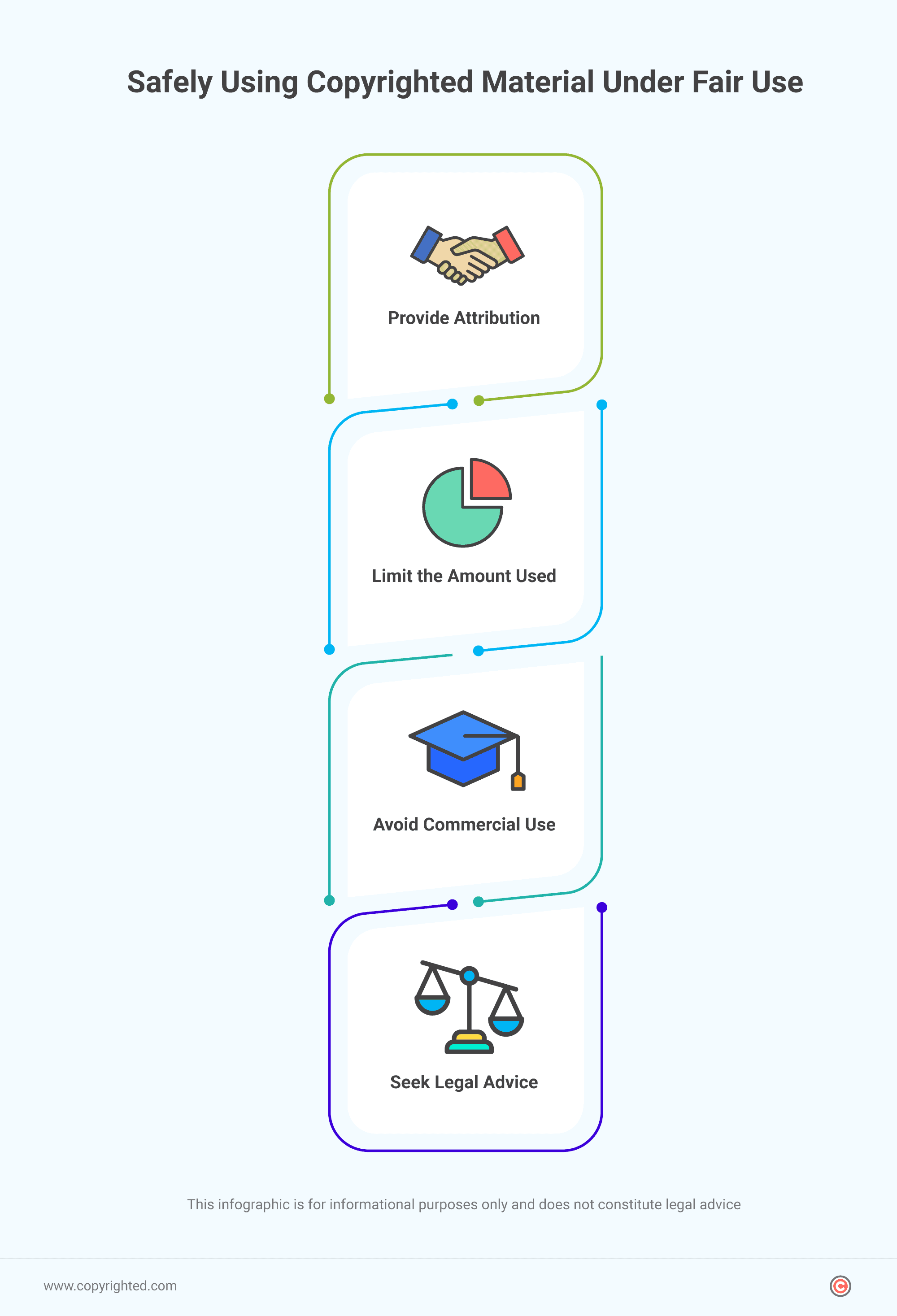While the internet makes it easy to share and consume content, it also brings complexities, especially when reusing content.
You might have wondered whether using works from the past requires attribution or poses copyright risks. This uncertainty often arises in discussions about terms like public domain and fair use, leaving many puzzled.
In this article, we’ll define these terms and clarify the distinctions between public domain and fair use.
Whether you’re thinking about repurposing content for articles or promotions, understanding these concepts is important. It ensures that your creative pursuits not only stay fresh but also comply with legal standards in the digital realm.
- Fair Use involves using copyrighted material with conditions, while public domain consists of works free from copyright and are accessible to everyone.
- Safely use works in the public domain by providing attribution, limiting usage, and being cautious about potential risks.
- While the public domain offers creative possibilities, there are risks associated with using its content.
Table of Contents
What is the Difference Between Fair Use vs. Public Domain?
Fair use is a legal rule allowing the use of copyrighted material in specific situations without needing permission or payment to the copyright owner. It aims to balance content creators’ rights with the public’s interest in exchanging ideas.
Fair use lets you use copyrighted material for commentary, criticism, news reporting, teaching, scholarship, and research.
Public domain, on the other hand, includes works not protected by copyright law, available for anyone to use. These works can enter the public domain through various ways, like copyright expiration or the creator’s explicit waiver.
While both fair use and the public domain involve using copyrighted material, they are fundamentally different.
Fair use is a legal exception allowing specific uses under certain conditions. In contrast, the public domain consists of works not protected by copyright at all.
Fair use needs careful evaluation, while public domain works are freely available without such scrutiny.
Understanding this distinction is important when navigating copyright and fair use, especially if you’re working with creative or educational content.
Now, let’s illustrate the difference between public domain and fair use in a comparison table:

What is Creative Commons?
Creative Commons is a licensing framework that allows content creators to set specific permissions and limitations for the use of their work.
Creative Commons is different from regular copyright because it offers various licenses that let creators customize how others can use their work. It’s a useful tool for those who want to protect their ideas while also encouraging collaboration.
With Creative Commons, creators can show how they want their work shared and adapted. It’s a middle ground between strict copyright and giving up all rights in the public domain.
For example, an artist might use a Creative Commons license that lets anyone use their image as long as they give credit.
What Determines Fair Use?
Fair use involves a careful consideration of four factors that determine if you can legally use copyrighted material without permission from the copyright owner. Let’s take a look at these factors:
Purpose and Character of the Use
This factor looks at how the copyrighted material is being used. Courts often favor uses that are transformative in nature, meaning they add new expression and meaning.
If you create parodies, commentaries, or works with a different purpose than the original, it’s more likely to be considered fair.
Nature of the Copyrighted Work
The inherent characteristics of the copyrighted work also play a role in the Fair Use analysis.
Factual and published works get more protection under fair use than fictional or unpublished ones. Courts understand the need to share information, so they allow more use of factual or publicly available content.
Amount Used
Consider how much and how essential the part is from the original work.
If it’s a small and less important portion, it’s more likely fair to use. But if you take a significant part, even if it’s a small piece of the whole, it might not be seen as fair use.
Effect on the Market
Perhaps one of the most significant factors, this factor checks whether the use negatively impacts the market for the original work.
If the use replaces the need for the original, affecting its value, it’s less likely to be fair. Courts want to make sure fair use doesn’t harm the original work’s commercial success, keeping the creator motivated to make more original works.
If you go beyond just copying and add a new perspective or value, it makes your fair use claim stronger. Emphasizing transformation aligns with fair use’s goal to balance creators’ rights and public interests in encouraging creativity, commentary, and sharing ideas.
So, when dealing with fair use, remember that transforming the original work adds legitimacy to your creative efforts.
How Can You Safely Use Copyrighted Material Under Fair Use?

Incorporating copyrighted material under the umbrella of fair use involves a balance of creativity and legal responsibility. Here are some tips to ensure you stay within the bounds of fair use:
- Provide Attribution: When using copyrighted material under fair use, it’s important to give credit where credit is due. Providing clear and proper attribution to the original copyright holder not only acknowledges their intellectual property but also strengthens your fair use argument.
- Limit the Amount Used: Selective and minimal use ensures that your work remains within the bounds of fair use, reducing the risk of copyright infringement. Avoid unnecessary replication of entire works, instead, focus on the specific elements that serve a transformative purpose.
- Avoid Commercial Use: While fair use can be a valid defense in certain scenarios, avoiding commercial use strengthens your position. Non-profit and educational uses are generally viewed more favorably under fair use, as they align with the doctrine’s principles of promoting educational, critical, and transformative uses.
- Seek Legal Advice if Uncertain: If you find yourself uncertain about the application of fair use in a particular situation, seeking legal advice is a smart step. Legal professionals with expertise in copyright law can provide guidance based on the specifics of your project.
Simply put, using copyrighted material under Fair Use requires knowing the copyright law, and making smart choices. Remember, being responsible and informed is essential for creating content within the law.
What Are the Reasons When Works Fall Into the Public Domain?
Works transitioning into the public domain can be attributed to several factors, each shedding light on the dynamic nature of copyright law:
Copyright has Expired
One primary reason for works entering the public domain is the expiration of copyright protection.
Copyright isn’t eternal, it has a finite duration. Generally, it lasts for the creator’s lifetime and extends for a set number of years beyond that.
Once this period elapses, the work automatically becomes part of the public domain. This ensures that creative works eventually contribute to the collective cultural heritage, creating a continuous cycle of innovation and access.
No Copyright Registration
Interestingly, some works find their place in the public domain simply because their creators didn’t register them for copyright protection. Copyright registration is not a mandatory step, but it serves as a formal declaration and offers additional legal benefits.
Works lacking this formal registration may not enjoy the full spectrum of copyright protection and may eventually enter the public domain more quickly.
Created Before Copyright Laws
Additionally, work published before the establishment of copyright laws automatically enters the public domain. As these creations predate the legal framework, they aren’t subject to copyright protection
Creator’s Waiver
Another avenue leading to the public domain is the removal of copyright by the creator. If a creator waives their rights and dedicate their work to the public domain, it becomes free for anyone to use without restriction.
When a creator willingly gives up their copyright, it shows they want to share their work freely with everyone.
What Are Examples of Works That Are in the Public Domain?
To illustrate the concept of public domain, here are specific examples showcasing works that have become freely accessible over time:
Jane Austen’s Novels
The timeless novels of Jane Austen, including classics like “Pride and Prejudice” and “Sense and Sensibility,” have gracefully entered the public domain. As these works were penned so long ago, they are no longer protected by copyright, giving everyone the liberty to explore, adapt, and enjoy these literary gems without legal constraints.

Beethoven’s Symphony No. 5
The iconic Symphony No. 5 by Ludwig van Beethoven, a musical masterpiece from the early 19th century, has likewise become a part of the public domain. Musicians, educators, and enthusiasts can freely use and share this musical composition without copyright restrictions.
Ancient Greek Philosophical Texts
The philosophical writings of ancient Greece, like those by Aristotle, Plato, and Socrates, have been in the public domain for a while. These essential texts, which greatly influenced Western thinking, are available for everyone to explore and study.
Are There Any Risks in Using Public Domain Works?
Using works in the public domain is usually considered safe, but it’s important to be careful because there can still be risks.
Misattribution
Incorrectly assuming a work is in the public domain when it’s still under copyright protection can lead to legal challenges. To avoid issues, it’s important to carefully research and confirm if a work is really in the public domain before using it.
Derivative Works
Even though public domain works can be freely used, making changes or adaptations (derivative works) from them can bring legal problems. Even if the original material is in the public domain, some parts of the changes might still have copyright protection.
Unclear Status
Determining if an older work is in the public domain can be complicated. The rules for when copyrights end are different, and things like renewals or international agreements can affect it.
This uncertainty can make it unclear if a work is in the public domain. In such cases, it’s essential to ask questions like “what does subject to copyright mean” in a given legal or historical context. Doing thorough research or consulting a legal expert—can help clarify a work’s true copyright status.
Frequently Asked Questions
What sets fair use apart from the public domain?
Fair use involves specific legal criteria, while the Public Domain comprises works not protected by copyright.
Is attribution necessary for works in the public domain?
No, works in the public domain can be used freely without the need for attribution.
Can you freely use works created before copyright laws existed?
Yes, works created before copyright laws entered into force automatically enter the public domain.
What risks are associated with using public domain works?
Misattribution and potential legal issues in creating derivative works.
What are the legal considerations for repurposing content online under fair use?
Provide attribution, limit usage, avoid commercial use, and seek legal advice if uncertain.
How can you determine the public domain status of older works?
Thorough research and, if needed, consultation with legal professionals can clarify the public domain status of older works.


